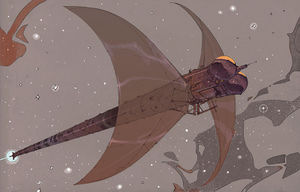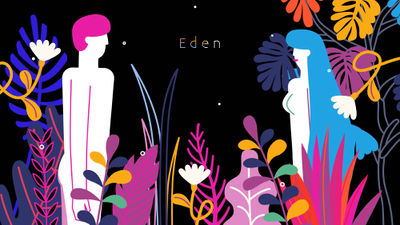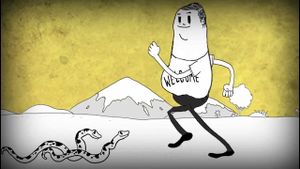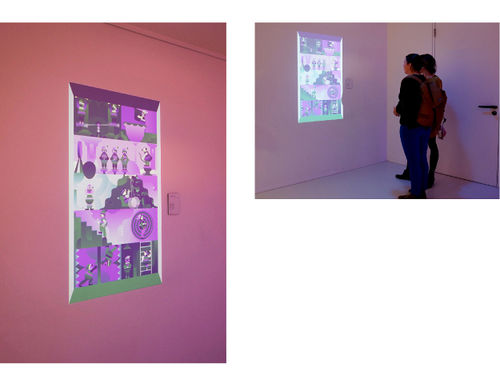Shinyoung : TEXT on METHOD 1st draft
TEXT ON METHOD - 'The Looping World
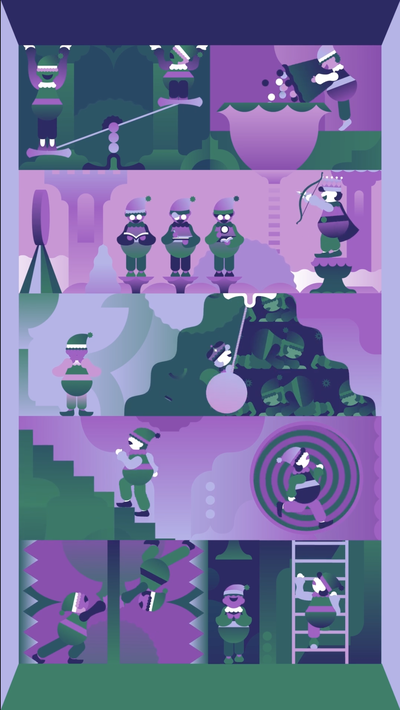
Introduction
My recent work ‘The Looping World’ was a part of my master curriculum in Piet Zwart Institute. When I was working on it, since I was not used to involving such research, most of the steps that I have made are new to me. In other words, I tried to approach the topic from a different starting point and also tried with the different procedure from what I was accustomed to; rather than focusing on how to translate into a 2D world, I put more time to build up the concept and message. However, I wanted to keep the root of my visual style which is still growing its branches since I hopped on to the field. Through this text, I would like to rethink about ‘The Looping World’ with an analytical view to find out what I have achieved and to discover a new room for my improvement.
Background Information
Research lab 2018 in EYE FILMMUSEUM AMSTERDAM is part of my master's curriculum. Students from UvA with similar master's course and ours were required to work as a group and had a series of reading sessions. Furthermore, all the participants were required to create their own works based on the theme as its name shows: 'THE UTOPIA/ DISPOPIA PROJECT’.
Procedure
This section shows what steps I have made during the working process. I first simply started with desk research about the utopia and dystopia. I had a series of reading sessions with a tutor and other participants exploring a wide range of critical, literal and philosophical reflections on the theme concepts. It was quite helpful in terms of listening to other’s view on the same topic and having a room for discussion about their view points. Diverse sources were given to us such as texts including essays, fictions, poem as well as movies. Through these reading sessions, I was able consider and develop diverse approaches on how to translate a subject to an actual work. Although I found most of the people were coming up with a plot or things to symbolize the term, I wanted to focus on its meaning. As for the methodology for my research, I tried to narrow my search to “the current definition of utopia” including the usage in sentences during my desk research. Next, I tried to look on its origins; who made the term and its initial meaning. Then development on the definition were searched.
Research
As I have mentioned, based on these research, I was able to come up with my own definition of 'Utopia', which later was used to structure the message and the theme of my result. In the beginning, I was planning to focus on Utopia, but as the data about the limitation for realizing Utopia accumulated, my theme was leaning towards Dystopia. First of all, I was interested in a paradoxical fact that Utopia is imagined as an idealized society in general, but the term Utopia derived from the Greek means “no place”.
The following sources were mainly referenced.
*Le Papillon des étoiles
A novel Le Papillon des étoiles written by Bernard Werber, a famous French science fiction writer, is a story of a society in a spaceship called Papillion. Their journey is to escape from wars and violence happening in the Earth and to realize a peaceful utopian society. The message of the book is "the perfection is rather a fatal mistake causing a harsher future than before." In the book, the chosen individuals had the privilege to be a passenger of the spaceship Papillion, which was constructed by a group of selected people who wants to escape from all the violence, wars, crimes and other disasters. The spaceship was launched and as the generation passes, the things that they were trying to escape from was already happening inside. This controversial message led me to think of utopia as a more negative term, which was quite similar to the definition of dystopia. This, I guess, might be also influenced by other literature, which states that Utopia never existed due to greediness. As the attempts are still being made, this cycle is an on-going process of construction and destruction.
*The Utopia Experiment
‘The Utopia Experiment’ led by Dylan Evans is about establishing and running of a micro-community of catastrophists as an experiment. In his book, which is about the experiment, he said that “To call something Utopian is...not entirely positive...The connotation of a perfect society is offset by that of a hopelessly impractical ideal”. Although I have not thoroughly read all the book, I was inspired by the concept of not being entirely positive. Which facilitated my definition to be focusing on a hopeless ideal.
*Why We Would Be Happier Without Utopia | Ewan Morrison | TEDxOxford
Video link : https://youtu.be/2dRlssVF7fc
The episode by Ewan Morrison, an award-winning Novelist, and Filmmaker, explains why Utopia is an idea that always leads to disaster and why thinking about Utopian solutions always makes us miserable in this lecture. He believes we would live happier lives if we erased this impossible place from our mental maps, once and for all and asks us to reframe our ideas of social justice and change without Utopia as an imagined endpoint. This is one of the source that I have mentioned which contains the message: "Utopia never existed due to greediness".
*Conclusion
Historically, there were many attempts to realize the Utopia which is the ideal society with some substantiated theories. Most of them were failed to persuade all the population with diversions. Each person has different desires which led to conflicts. Many theories were structured by ambitions of human who eager for a better world, but the theories were collapsed by the ambitions. This phenomenon has been repeated in the history of mankind. These messages were based to formulate my own definition of Utopia as the following sentence.
Ideal place, being simultaneously constructed and demolished and never completed but still being attempted by human beings who eager to be the first to complete one
The next step was to figure out and create the place where to convey this.
My Visual Language
Normally, I introduce myself as an animator and an illustrator who has strong fascinations toward colorful, bold and aesthetic 2D imagery. I am considering my works to be visually strong and always aiming to have my own distinctive visual language. My works deliver enjoyment and empathy with character animation. Most of my works are based on characters formed in a human or animals and it is a fundamental tool of storytelling. I set a virtual space where the characters are living and I reflect a realistic world on the space. Through the characters narrating a story, I communicate with audience to feel empathy and to find a hidden message behind their actions and feelings. For example, my representative animation ‘Eden’ is a music video, with reformulated story from Adam and Eve, and I got rid of the shame of nudity and the first sin of mankind in favor of focusing on what the tale of Adam and Eve is at its core: a love story. As an artist who prefers friendliness to be involved to emerge collaborative views from the audiences, having a critical view and expressing the oppression was not my strength, which led me to avoid this feature on my artwork plots. Nevertheless, I always was preparing to include certain critical views on my works. In this regard, ’The Looping World’ including the pessimistic message was a good challenge to reach my critical voice with a satisfying result.
Contents
In order to show the controversial message of Utopia, I decided to create a world with distinctive social status rankings. In this world, two distinctive themes are shown. One theme shows people craving for changes with their actions. For example, a person keeps going up the stairs but he stays at the same height. The other theme demonstrates two parties fighting to win the better bipolar result. For example, two people are standing on each end of scale. When one person stretches out his body, the other person squashes. People in this world represent all humankind and the two types of situations imply all the attempts to realize Utopia for their own desires with their own ways. I was inspired by an image of a building with people from different floors being busy with different actions. I decided to create my work with vertical ratio, not a normal horizontal one due to two reasons. First is to convey my inspiration, the people with different purpose acting simultaneously in a tall vertical building. Second is to deliver the main themes that I have explained while pleasuring audiences by offering them time to spot details.
Storytelling tools
What I felt most difficult while working on the project is linking my visual language with the pessimistic message. I think my visual language has a tendency to be optimistic with colorful and bold shaped in design evoking the feminine mood. Thus, I have been always trying to develop my own way of storytelling, which is non-controversial and empathic such as love story, humorous material. Somehow, it is quite tricky when it comes to pessimistic themes. I came up with black comedy as a tool of storytelling. This style of humor has a big advantage in bringing a particularly contentious issue on the table with everyone’s laughter. It provokes both positive and negative moods in a good balance as it was used in numerous literature, movies and plays throughout history. A famous short animation MAN by Steve Cutts is one of a good example using black humor method to convey a critical message in 2d animated form. I thought this genre can be an effective and powerful tool I can apply. I chose to put cute characters acting cruel and hopeless to let the viewers have a more dramatic feeling. Thus, I set dwarfs who express emotions only with their lower part of his face as the representation of modern society. To bring the fairy tale mood corresponded to the dwarf design, I created background based on a castle. Color variation was prioritized based on gloominess rather than brightness.
Sound
'The Lopping World’ is a looping video which is a non-linear narrative. As I mentioned, people in my video are in different situations happening at the same time. The form is similar with Polish avant-garde animated film Tango, directed by Zbigniew Rybczyński, which shows many people in a closed space performing repetitive activities. In his film, he added all the sound effects on people’s different actions such as sound of crying baby, opening door and so on. I was thinking about putting different sound effects following people’s actions like the Zbigniew’s film, but I was also afraid it becomes too crowded and busy. Thus, I decided to insert only background soundtrack (El Búho - Cumbia De Tototl) which brings the mood of my animation.
Conclusion
Video link : https://vimeo.com/258524921
As a result, I made a 9:16 ratio vertical animation which is being looped. It was exhibited in a hallway of the museum during the exhibition, not screened in the cinema like other participants’ films, because of its different film ratio and characteristic of storytelling method which is being looped forever. I was happy to see some people carefully investigating on my work to receive some face-to-face feedbacks.
Appendix
description of the Looping world
Human beings have been struggling to live in an ideal world with ambition. Those efforts and struggles have initiated with human’s natural desire to exceed the limitation of current society and to realize the ideal society: Utopia. Through our history, numerous theories toward utopian society have been adduced by thinkers and politicians throughout the East to West. Confucius emphasized a society performed by human agents and embodying the civilized and cultured patterns of behavior developed through generations of human wisdom. Lao-tzu believed an acknowledgement of the natural law against to an artificial environment which makes people behave badly. In Western philosophy, Plato, a Greek philosopher, claimed that “philosopher kings” should be the rulers of nations to realize justice ruled by knowledge. Utopian society was characterized by egalitarian principles of equality on government, economics, religion, sexual and other factors, reflecting the spirit of Renaissance-Humanism. Since the 20th century, Ideology, a structure of Idealism which explains human world and modifies it, has been emerged in many different forms. Marxism aimed to collapse hierarchical society by prohibiting private property against capitalism, and Anarchism advocates self-governed societies based on voluntary institutions in order to hold the state of equal and free from any oppression. Those ideologies are seen as a part of revolutions for claiming the equal. However, limitations were faced to realize admirable equally world with this single theory. If revolution theory is scientific, there would be a definite answer. Yet, revolution is not a predictable science, therefore, unavoidable variable matters are occurred. The most fatal matter people did not recognize was all human beings are greedy animals which never fulfils their satisfaction. This is a driving force toward the ideal society to overcome current limitation and also the most decisive factor which destroys their ideal society. Human wishes to accomplish a world without capitalism, yet human nature is completely capitalist. In addition, human growth engines are hindered when equality and freedom reach a certain standard. As the history shows, eagerness for better world have structured the current society; nevertheless, it is the eagerness which also demolishes the world. The world is structured by ambitions of human who is eager for better world, and the world is destructed by the ambitions.
References
- https://en.wikipedia.org/wiki/Utopia
- Why utopian communities fail Retrieved 08 March 2018
- Utopia: Nine of the most miserable attempts to create idealised societies Retrieved 21 February 2016
- The Utopia Experiment by Dylan Evans review – a community of misfits Retrieved 12 Feb 2015
- Why we would be happier without Utopia | Ewan Morrison | TEDxOxford | 2016
- MAN | Steve Cutts | 2012
- Tango | Zbigniew Rybczyński | 1980

